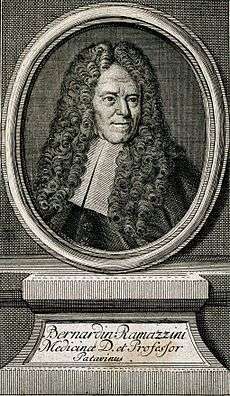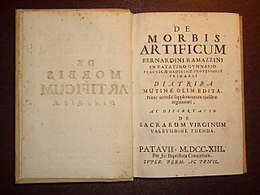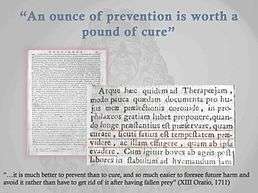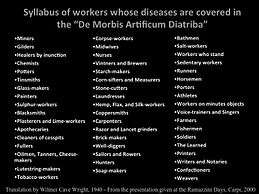Bernardino Ramazzini
| Bernardino Ramazzini | |
|---|---|
 Bernardino Ramazzini | |
| Born |
4 October 1633 Carpi |
| Died |
5 November 1714 (aged 81) Padua |
| Nationality | Italian |
| Alma mater | University of Parma |
| Known for | cinchona, occupational medicine |
| Scientific career | |
| Fields | medicine |
| Institutions | University of Modena, University of Padua |
Bernardino Ramazzini (4 October 1633 – 5 November 1714) was an Italian physician. (Italian pronunciation: [bernarˈdino ramats'tsini])
Ramazzini, along with Francesco Torti, was an early proponent of the use of cinchona bark (from which quinine is derived) in the treatment of Malaria. His most important contribution to medicine was his book on occupational diseases, De Morbis Artificum Diatriba ("Diseases of Workers").
Life
Ramazzini was born in Carpi on 4 October 1633 according to his birth certificate.[1] He studied medicine at the University of Parma, where his interest in occupational diseases began.
Career
He was appointed to the chair of theory of medicine at University of Modena in 1682 then served as professor of medicine at the University of Padua from 1700 until his death. He is often called "the father of occupational medicine" [2][3]
The first edition of De Morbis was published in 1700 in Modena, the second in 1713 in Padua.
Occupational medicine



His book on occupational diseases, De Morbis Artificum Diatriba (Diseases of Workers) outlined the health hazards of chemicals, dust, metals, repetitive or violent motions, odd postures, and other disease-causative agents encountered by workers in more than fifty occupations.[4] This was one of the founding and seminal works of occupational medicine and played a substantial role in its development.[2] [3]
He proposed that physicians should extend the list of questions that Hippocrates recommended they ask their patients by adding, "What is your occupation?".[2]
Ramazzini saw prevention as being better than cure. In his Oratio given in 1711, he suggested that "it is much better to prevent than to cure, and so much easier to foresee future harm and avoid it rather than have to get rid of it after having fallen prey".
Malaria
In regards to malaria, Ramazzini was one of the first to support the use of the quinine-rich bark cinchona. Many falsely claimed that quinine was toxic and ineffective, but Ramazzini recognized its importance. He is quoted, "It [quinine] did for medicine what gun powder did for war."[5]
Cancer
In 1713, Bernardino Ramazzini said that nuns developed breast cancer at a higher rate than married women, because they did not engage in sexual intercourse, and the "unnatural" lack of sexual activity caused instability of the breast tissues that sometimes developed into breast cancer.[6]
Death
Acknowledgement
In a lifestyle article "Sitting can lead to an early death," the writer acknowledged Ramazzini's pioneering study of this field in the 17th century.[8]
References
- ↑ "Ethical values and virtues of the Diatriba. A tribute to Bernardino Ramazzini on the tercentenary of his death (1714)". Researchgate.net. Retrieved 2017-07-25.
- 1 2 3 Gochfeld, Michael (February 2005). "Chronologic history of occupational medicine". Journal of Occupational and Environmental Medicine. 47 (2): 96–114. doi:10.1097/01.jom.0000152917.03649.0e. ISSN 1076-2752. PMID 15706170. Gochfeld, Michael. "Chronologic history of occupational medicine" (PDF). Archived from the original (PDF) on 13 September 2006. Retrieved 3 March 2009. A PDF copy of the article.
- 1 2 3 Ramazzini, Bernardino (1 September 2001). "VOICES FROM THE PAST – De Morbis Artificum Diatriba (Diseases of Workers)". Am J Public Health. 91 (9): 1380–1382. doi:10.2105/AJPH.91.9.1380. PMC 1446785. PMID 11527762. Retrieved 1 March 2009. The article contains excerpts from the English translation by Wilmer Cave Wright (Chicago: University of Chicago Press; 1940) based on the Latin text of 1713, and includes a biographical note, Bernardino Ramazzini: The Father of Occupational Medicine, by Giuliano Franco, MD and Francesca Franco MD, MPH
- ↑ Cockayne, Emily (2007). Hubbub: Filth Noise & Stench in England. Yale University Press. p. 61. ISBN 978-0-300-13756-9.
- ↑ Poser, Charles M; Bruyn, GW (1999). An illustrated history of malaria. New York: Parthenon Publishing. ISBN 978-1-85070-068-5. OCLC 40354694.
- ↑ Olson, James Stuart (2002). Bathsheba's breast: women, cancer & history. Baltimore: The Johns Hopkins University Press. pp. 32–33. ISBN 0-8018-6936-6.
- ↑ "History". Collegium Ramazzini. Retrieved 3 March 2009. History (of Occupational Medicine) with notes on the life of Ramazzini.
- ↑ Han, Esther (28 March 2012) Sitting can lead to an early death. Sydney Morning Herald
Bibliography
- Essai sur les Maladies de Disseus. Original translation from Latin in "De Mortis Artificum" by M. De Foureau
- Altschuler, Eric Lewin (2005). "Ramazzini and writer's cramp". The Lancet. 365 (9463): 938. doi:10.1016/S0140-6736(05)71080-1. PMID 15766994.
- Marin, V Terribile Wiel; Bellinati C; Panetto M; Zanchin G (November 2003). "Bernardino Ramazzini lies in Padua". The Lancet. 362 (9396): 1680. doi:10.1016/S0140-6736(03)14817-9. PMID 14630462.
- Franco, G (September 1999). "Ramazzini and workers' health". Lancet. 354 (9181): 858–61. doi:10.1016/S0140-6736(99)80042-7. PMID 10485743.
- "Bernardini Ramazzini (1633–1714) physician of the tradesmen". JAMA. 210 (13): 2391–2. December 1969. doi:10.1001/jama.210.13.2391. PMID 4902526.
- Bisetti, A A (1988). "Bernardino Ramazzini and occupational lung medicine". Ann. N. Y. Acad. Sci. 534 (1): 1029–37. doi:10.1111/j.1749-6632.1988.tb30193.x. PMID 3291704.
- Zanchin, Giorgio; Capitanio Mariatonia; Panetto Monica; Visentin Guido; Marin Vito Terrbile Wiel (June 2005). "Bernardino Ramazzini rests in Padua". Vesalius : acta internationales historiae medicinae. 11 (1): 15–20. PMID 16208850.
- Hook, G E (November 1995). "Ramazzini: father of environmental health?". Environ. Health Perspect. Brogan &. 103 (11): 982–3. doi:10.1289/ehp.95103982. JSTOR 3432616. PMC 1519185. PMID 8605856.
- Pope, Malcolm H (October 2004). "Bernardino Ramazzini: the father of occupational medicine". Spine. 29 (20): 2335–8. doi:10.1097/01.brs.0000142437.70429.a8. PMC 1446786. PMID 15480150.
- Franco G, Franco F. Bernardino Ramazzini: The Father of Occupational Medicine. Am J Publ Health 2001;91:1380-1382
- Franco G, Fusetti L. A. Bernardino Ramazzini's early observations of the link between musculoskeletal disorders and ergonomic factors. Appl Ergonom 2004;34:67-70.
- Franco G. Ramazzini and workers’ voice disorders. Otolaryngol Head Neck Surg 2008;139:329
- Franco G. Work-related musculoskeletal disorders. A lesson from the past. Epidemiology 2010;21:577-579
- Franco G. Health disorders and ergonomic concerns from the use of microscope: A voice from the past. Am J Clin Pathol 2011; 135:170-171
- Franco G. Bernardino Ramazzini and women workers’ health in the second half of the seventeenth century. J Public Health 2012;34:305-308
- Franco G. A tribute to Bernardino Ramazzini (1633-1714) on the tercentenary of his death Occ Med 2014;64:2-4
- Carnevale F, Iavicoli S. Bernardino Ramazzini (1633-1714): a visionary physician, scientist and communicator. Occup Environ Med 2015;72:2-3.
- Franco G. La lezione di Bernardino Ramazzini, medico sociale e scienziato visionario. Acc. Naz. Sci Lett. Arti di Modena - Memorie Scientifiche 2015;18:49-62
External links
| Wikimedia Commons has media related to Bernardino Ramazzini. |
- Ramazzini Collegium The Collegium supplies information on risks and prevention of injury and disease attributable to the workplace and the environment.
- Some places and memories related to Ramazzini.
- Presentations and publications on Ramazzini's famed work "De Morbis Artificum Diatriba"
- Celebrazioni del tricentenario della morte Bernardino Ramazzini, a pioneer of public health - Presentation given on occasion of the event “Bernardino Ramazzini, three-centenary from death”. University of Padua, 18 October 2014
- Tercentenary of the death
- De fontium mutinensium admiranda scaturigine ; tractatus physico-hydro-staticus. - full digital facsimile at Linda Hall Library
- Franco G. Meglio prevenire che curare – il pensiero di Bernardino Ramazzini, medico sociale e scienziato visionario. Narcissus, 2015